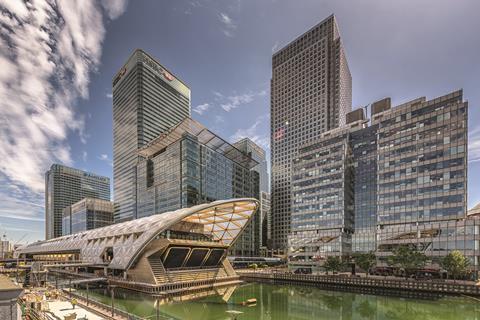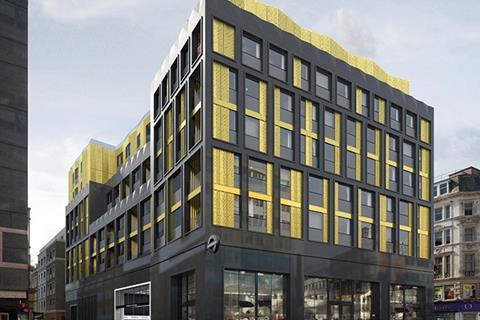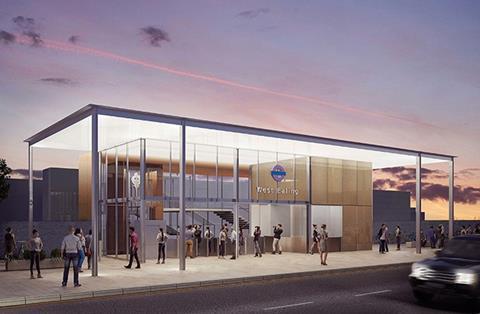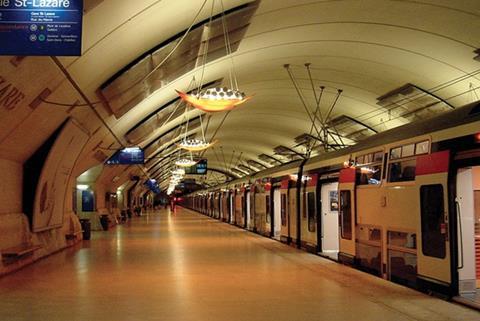As Crossrail celebrates a trio of significant milestones, Ike Ijeh takes a look at the current state of play with the biggest expansion to London’s public transport infrastructure since the Second World War

Over the past two months Crossrail has celebrated three significant milestones that together mark a huge step forward towards the completion of the massive £14.8bn railway project. Firstly, the underground railway tunnels that have bored their way 40m under central London for the past three years were completed. Secondly, the retail and public gardens section of Foster + Partners’ Canary Wharf Crossrail station were also opened to the public.
And in a final development that garnered by far the least publicity, but is arguably of the greatest operational significance, tube maps now indicate that Transport for London (TfL) has quietly assumed control of the former National Rail route between Liverpool Street station and Shenfield. This is in anticipation of these services eventually being provided exclusively by Crossrail, which in turn will be fully administered by TfL.
These three milestones essentially mean that Crossrail is still well on track to launch services in 2018, as planned. But even getting to the point where Crossrail now is has been a mammoth undertaking. Eight 1,000-tonne tunnelling machines have bored 26 miles of 6.2m-diameter tunnels under some of the most historic and densely populated parts of the city. Ten stations are being significantly expanded, the biggest addition to the London’s underground rail network since the opening of the Jubilee line extension in 1999. And with 10,000 employed on the project across 40 construction sites, Crossrail has a workforce bigger than the residential population of the City of London.
But, despite the achievements so far, future challenges lie ahead and new deadlines are already on the horizon. Crossrail has reached the halfway mark on several of the flagship central London stations and fit-out will proceed over the next two years. By late next year the completion of new ticket halls on several of these central section stations is expected. By 2017, Crossrail rolling stock will appear on the Shenfield to Liverpool Street suburban branch in advance of the opening of the tunnelled section the following year.
So, here is an update of what lies in store over the next few years for a railway that will provide the biggest expansion in London’s public transport capacity since the Second World War.

Surface developments
While Crossrail is clearly transforming London’s subterranean landscape, it is also having a significant impact above ground. Naturally, this trend will accelerate as the scheme moves closer to completion. Due to the inordinate length of Crossrail platforms (a quarter of a kilometre), several stations have provoked two entirely separate above-ground developments clustered around entrances at either end. Seven significant over-site development sites have been identified along the Crossrail route: Bond Street, Farringdon, Liverpool Street, Paddington, Tottenham Court Road and Holborn in central London and Woolwich in south-east.
Arguably the biggest of these developments will be at Tottenham Court Road, which provides a apt example of the enormous impact Crossrail will have on the built fabric, urban streetscape and public realm at all stations.
For several years this major central London interchange has been in a transformative state; shrouded behind hoardings and with all its major road arteries diverted. When complete, two new developments will have emerged – a 105,000ft² residential block by Hawkins\Brown on Oxford Street and a 380,561ft² mixed-use AHMM scheme on two sites on and near St Giles’s Circus.
As well as this the junction between Oxford Street and Tottenham Court Road itself will be completely redesigned with significantly expanded public space located around two new entrances to the tube and Crossrail ticket halls. The upheaval has not been without its controversy. The redevelopment required demolition of a number of iconic music venues, such as The London Astoria and the Mean Fiddler, and many have bemoaned the threat that Crossrail presents to the identity and survival of London’s adjacent music quarter.
But Crossrail will have a property impact far beyond these individual station-related projects. Property consultants have estimated that Crossrail could help add £5.5bn to residential and commercial real estate along its route and have identified up to 3 million ft2 of related development in areas surrounding its stations.

The value of design
The 11 new stations on the Jubilee line extension which opened in 1999 are widely hailed as a defining chapter in the history of 20th century UK infrastructure design, whose stellar architectural quality and variety briefly recaptured the pioneering ambition and spirit of the Victorian railway era.
But there were two problems: the Jubilee line extension came in precipitously late and wildly over budget. In so doing it thoroughly anaesthetised central government to the charms of architectural largesse and ushered in an age of railway design defined by functionality and standardisation.
The first London product of this new age was the East London line extension, which opened in 2010. Stations were workmanlike; compact and robust but hardly considered works of art. Crossrail, however, promises more mixed results. In the spirit of the Jubilee line, high-profile architects with strong international experience of station design, such as Foster + Partners, Wilkinson Eyre and Grimshaw have designed individual stations.
But at the same time, in 2013 it was controversially announced that the Crossrail design review panel set up by Design Council Cabe in 2009 would not review 27 outer London stations, a decision that has since been reversed. And stations such as Ealing Broadway, whose latest redesign was released last month, have attracted stern criticism for their dull and uninspiring form.
Two of Crossrail’s partially completed stations indicate the design variance that seems to characterise the project. With its monumental scale, elevated gardens and soaring glulam and ETFE roof, Canary Wharf station exerts a tangible sense of civic drama.
At the other end of the scale, Farringdon’s inoffensive but hopelessly bland concrete box demeans the astonishing richness of its local context and meanly impoverishes the commuter experience. With further stations set to be unveiled from late next year, time will tell how other stations and the line as a whole will fare in design terms. But what seems already clear is that while Crossrail certainly doesn’t lack architectural skill and ambition, it may struggle to capture the overall architectural vision and coherence that has been the defining feature of great British railway design from the Victorian terminals to the London Underground.

Crossrail 2: The future
There was a time, in the not too distant past, when the realisation of Crossrail seemed such an impossibility that any mention of Crossrail 2 seemed mired in the realms of fantasy and delusion. Today, while Crossrail 2 is still far from reality, it is no longer a work of fiction either. Earlier this year chancellor George Osborne confirmed that safeguarding for Crossrail 2 had been agreed.
Safeguarding is essentially the legislative process by which an area identified for a future railway route can be protected from potentially conflicting development. It’s a far cry from actual construction but it’s an important initial step in the life of any new railway.
While Crossrail 1 charts an east-west path through the capital, Crossrail 2 aims to link south-western London suburbs like Wimbledon and Tooting to their north-eastern equivalents in places like Dalston and possibly Hackney. A central tunnel link will pass though Victoria and Chelsea with a planned major intersection with Crossrail 1 at Tottenham Court Road. Beyond this there is a further regional option that could see extensions to Cheshunt and Epsom. The line was initially referred to as the Chelsea-Hackney line when it was first conceived in the 1970s, a reference to the fact that those two areas had been identified as historic voids in the tube system, an omission now partially resolved by their inclusion on the London Overground network.
With London’s population set to top 10 million by 2030, Crossrail 2 has been identified by various bodies as an essential next step in London’s public transport development. A recent London Chamber of Commerce and Industry poll found that 44% of London businesses identified it as their top transport priority.
But London has a historically glacial approach to major infrastructure expansion and none of this widespread support guarantees that Crossrail 2 will overcome the significant obstacles that lie ahead. Funding for the scheme, most recently pitched at between £20bn to £27bn, is far from secure and TfL’s plan to start construction in 2020 is reliant on getting planning permission in 2020. Both of these depend on the content of the government’s Budget this week (see news pages). It’s also worth remembering that Crossrail 1 was safeguarded for 35 years before construction began. Before construction started the overwhelming sentiment that surrounded the Crossrail project was uncertainty. This looks set to be as significant a feature of its future as it was of its past.

RER: The Parisian Crossrail
While London may like to proudly proclaim the record-breaking engineering prowess of Crossrail, something that’s mentioned a lot less is the uncomfortable fact that our old rival Paris produced its own version almost 40 years ago.
Paris’ RER network received a grand presidential opening in 1977 and to all intents and purposes, it does the same thing as Crossrail. Prior to its completion Paris, like London, offered only two principal and largely autonomous forms of urban rail transit – the metro or the train. RER solved the problem by linking pre-existing suburban railway lines with a new underground city centre rail network, the same model as Crossrail.
Like London, Paris had harboured grand plans for a city centre underground railway system since post-war times. The difference was that while the French economy flourished in the 1970s when the bulk of RER construction took place, Britain’s was famously crippled by chronic underperformance and industrial strife.
Like Crossrail, RER was a gargantuan engineering exercise with deep-level tunnels and trains and station platforms up to three times longer than the conventional Paris metro. With typical Gallic je ne sais quoi there are no official accounts to verify conclusively the cost of RER but the fact that the equivalent of roughly £1bn was spent on it in 1973 alone suggests it was at least as expensive as Crossrail. One key difference with Crossrail is that RER has also provided new city centre stations. Hindsight suggests that Crossrail was probably wise to avoid these as in Paris these stations tend to be chronically underused.
When the RER initially opened it already incorporated its Crossrail 2 equivalent. Its two lines, A and B, provided cruciform north-south and east-west routes. Although today A and B remain the busiest lines in Paris and are used by well over a million people a day, they have now been joined by three other lines with further expansion planned. Considering how long it has taken London to secure Crossrail 1, the thought of up to four successors is currently inconceivable. Paris and RER also benefit from a level of political and fiscal self-determination that simply does not exist in London. While Paris controls over 80% of the revenue it raises, London controls only 7%.



























No comments yet